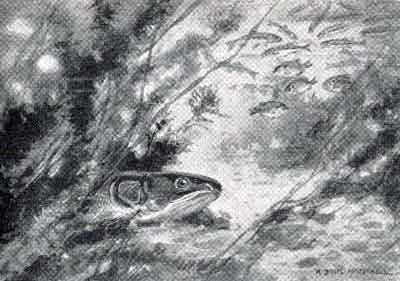The American Bowfin, Page 2
By H. REVELL WHITRIDGE
Nor does the great interest of zoologists in the bowfin stop here; Interest in it is increased by a study of its relationship to earlier types. The bowfin claims the distinction, along with the sturgeon, Acipenser, and the garfish, Lepisosteus, as the main species of ganoids, of being among our most primitive fishes. One of the most obvious of the bowfin's primitive characteristics is the long dorsal fin, which undulates with a graceful rhythmic movement. It is also interesting that it is from the bowfin line of the ganoids that we find the branch of Teleostei, or true bony fishes, descending, a group that comprises the great majority of existing fishes.
The bowfin is one of the few ganoids possessing a gular plate. Its air bladder is cellular, and of respiratory value. From the cycloidal scales, the structure of the fins, and the calcified skeleton, the bowfin seems to be of such modern character that zoologists, until recent years, included it in the herring group. Today, however, the bowfin stands out as the one species of its entire family still surviving, and seems to be found only in North America.

A SINISTER HEAD, ALMOST PERFECT IN ITS CAMOUFLAGE OF OLIVE GREEN
In its feeding habits, the bowfin is carnivorous and extremely voracious, its main diet consisting of crayfish, minnows, and other small fishes. The diet varies, of course, depending on the predominating source of supply. In examining the contents of the stomachs of those I have taken from Lake Leelanau in July and August, I find approximately eighty percent of their diet to be yellow perch. I have found six of these fish, ranging from four to seven inches, in the stomach of one bowfin. The balance of the bowfin's diet, in this lake and in these months, was about evenly divided between crayfish and minnows. It seems to feed at all hours, but I. have hooked my largest specimens in the heat of the day, between 10 A. M. and 3P.M.
I have never been successful in catching this fish on artificial lures. I have a friend, however, who caught one on a spoon, a mother-of-pearl affair, while trolling. Contrary to the usual report that it takes bait deliberately, I have found that when taking live bait, the bowfin strikes in various ways. In fact, it is difficult to know from the strike what kind of fish has attacked your bait. But it is generally a hard smashing drive.
The habit of designating fish by their colloquial names is often confusing, especially to the angler. The bowfin is known by various names in different sections of the country. Some of these names are; dog-fish, mudfish, sawyer, lawyer fish, grindle, and even prairie bass. The origins of these names seem to have been lost with the passing of the years. However, there is little doubt in my mind that the bowfin was originally called a dogfish because of its actions when hooked. Since catching my first bowfin, I have hooked and landed dozens of them, and the following example is characteristic of their actions. On this occasion the fish ran fully twenty-five yards in a direct line before I set the hook. About every ten feet I could feel a vicious shake of the fish's head, for all the world displaying the temper that causes a terrier to shake a rat. After this long run, I set the hook hard, in order to drive it through the bony mouth. The reeling-in consisted of pulling in an almost dead weight. But once alongside the boat, this fish again showed its dog-like temperament. It rolled on top of the water, and shook its entire body. I was certainly reminded of my own dog, holding to a piece of rope, refusing to let go, and disputing every inch of ground. I have had this experience time and time again.
 Printer-friendly version
Printer-friendly version
